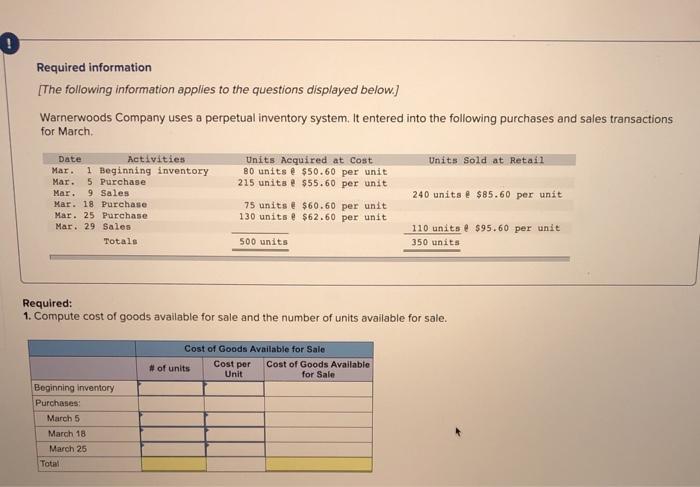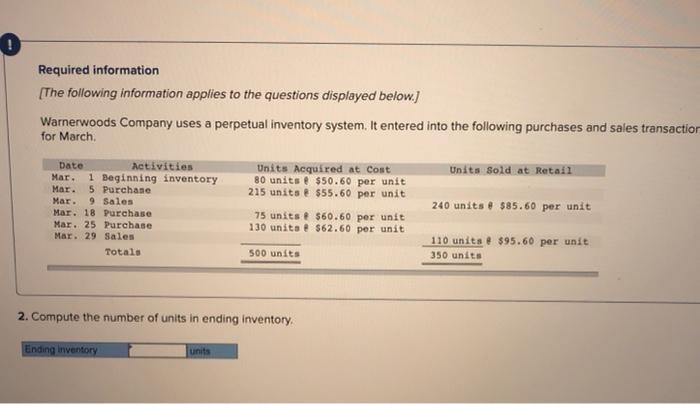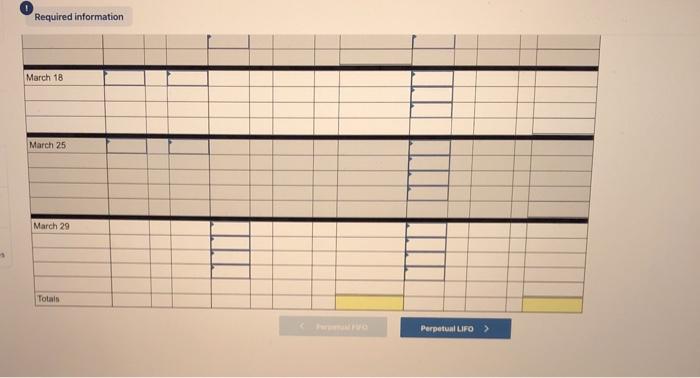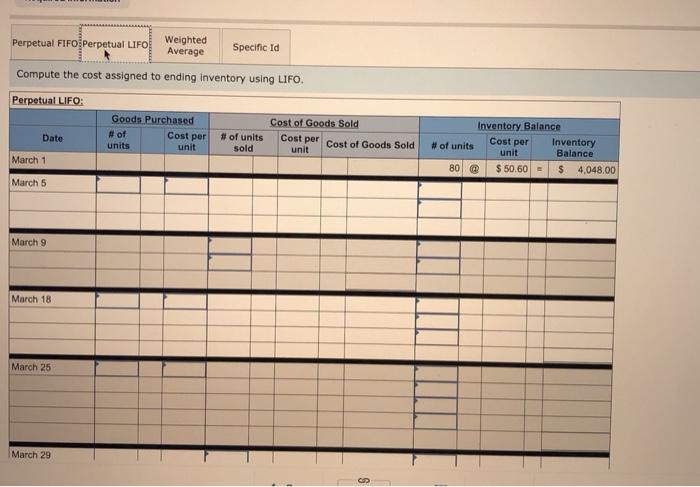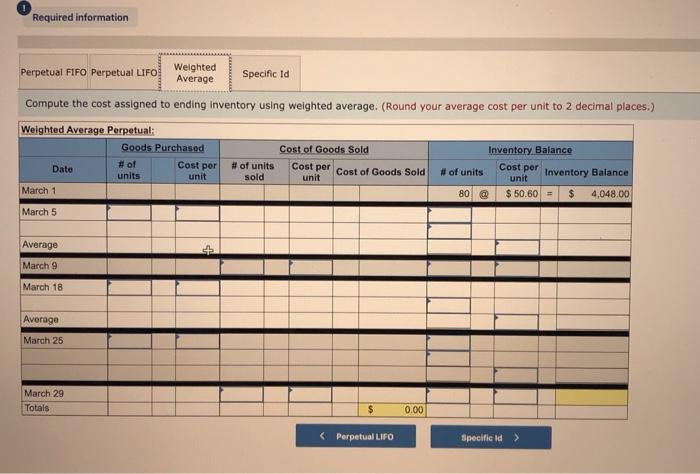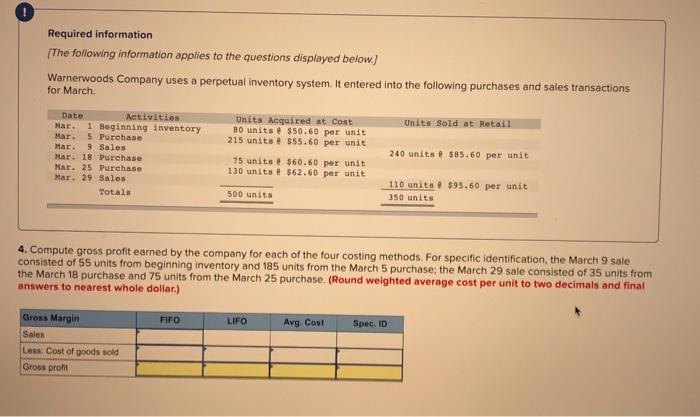Required information The following information applies to the questions displayed below.) Warnerwoods Company uses a perpetual inventory system. It entered into the following purchases and sales transactions for March Units sold at Retail Date Activities Mar. 1 Beginning inventory Mar. 5 Purchase Mar. 9 Sales Mar. 18 Purchase Mar. 25 Purchase Mar. 29 Sales Totals Units Aequired at Cost B0 units @ $50.60 per unit 215 unitse $55.60 per unit 75 units & $60.60 per unit 130 units e $62.60 per unit 240 units $85.60 per unit 110 units e $95.60 per unit 350 units 500 units Required: 1. Compute cost of goods available for sale and the number of units available for sale. Cost of Goods Available for Sale # of units Cost of Goods Available Unit for Sale Cost per Beginning inventory Purchases March 5 March 18 March 25 Total 0 Required information [The following information applies to the questions displayed below.) Warnerwoods Company uses a perpetual inventory system. It entered into the following purchases and sales transaction for March Activities Units Acquired at Cost Units sold at Retail 1 Beginning inventory 80 units $50.60 per unit 215 units & $55.60 per unit 240 units # $85.60 per unit 75 units # $60.60 per unit 130 units & $62.60 per unit 110 units e $95.60 per unit Totals 500 units 350 units Date Mar. Mar. 5 Purchase Mar. 9 Sales Mar. 18 Purchase Mar. 25 Purchase Mar. 29 Sales 2. Compute the number of units in ending inventory Ending Inventory units 3. Compute the cost assigned to ending inventory using (a) FIFO. (b) LIFO, (c) weighted average, and (d) specific identification. For specific identification, the March 9 sale consisted of 55 units from beginning inventory and 185 units from the March 5 purchase; the March 29 sale consisted of 35 units from the March 18 purchase and 75 units from the March 25 purchase. Complete this question by entering your answers in the tabs below. Perpetual FIFO Perpetual LIFO Weighted Average Specific to Compute the cost assigned to ending inventory using FIFO. Perpetual FIFO Goods Purchased Cost of Good Sold Cost per unit Date # of units W of units sold Cost per unit Cost of Goods Sold Inventory Balance Cost per # of units Inventory unit Balance 80 @ $50.60 $ 4,048.00 March 1 March 5 March 9 March 18 March 25 Required information March 18 March 25 March 29 Totals Perpetual LIFO > Perpetual FIFO Perpetual LIFO Weighted Average Specific Id Compute the cost assigned to ending Inventory using LIFO. Perpetual LIFO: Goods Purchased Cost of Goods Sold Date # of # of units units unit sold Cost of Goods Sold unit March 1 Cost per Cost per Inventory Balance # of units Cost per Inventory unit Balance 80 @ $ 50.60 - $ 4,048.00 March 5 March 9 March 18 March 25 March 29 Required information March 18 March 25 March 29 Totals $ 0.00 Required information Perpetual FIFO Perpetual LIFO Weighted Average Specific ld Compute the cost assigned to ending Inventory using weighted average. (Round your average cost per unit to 2 decimal places.) Weighted Average Perpetual: Goods Purchased Cost of Goods Sold Inventory Balance #of Cost per Date # of units Cost per units unit Cost per Inventory Balance # of units sold Cost of Goods Sold unit unit March 1 80 @ $50.60 = $ 4,048.00 March 5 Average March 9 March 18 Average March 25 March 29 Totals 0.00 Required information Specific Identification: Goods Purchased # of Cost per Date units unit March 1 Cost of Goods Sold # of units Cost per Cost of Goods sold unit Sold Inventory Balance Cost per # of units Inventory Balance unit 80 @ $50.60 = $ 4,048.00 March 5 March 9 March 18 March 25 March 29 Totals $ 0.00 Required information [The following information applies to the questions displayed below.) Warnerwoods Company uses a perpetual inventory system. It entered into the following purchases and sales transactions for March Units Aequired at Cost 80 units $50.60 per unit 215 units $55.60 per unit Unita Sold at Retail Date Activities Mar. 1 Beginning inventory Mar. 5 Purchase Mar. 9 Sales Mar. 18 Purchase Mar. 25 Purchase Mar. 29 Sales Totals 240 unit# # $85.60 per unit 75 units $60.60 per unit 130 units @ $62.60 per unit 500 units 110 units # $95.60 per unit 350 units 4. Compute gross profit earned by the company for each of the four costing methods. For specific identification, the March 9 sale consisted of 55 units from beginning inventory and 185 units from the March 5 purchase, the March 29 sale consisted of 35 units from the March 18 purchase and 75 units from the March 25 purchase. (Round weighted average cost per unit to two decimals and final answers to nearest whole dollar.) FIFO LIFO Avg Cout Spec.ID Gross Margin Sales Less: Cost of goods sold Gross pront
